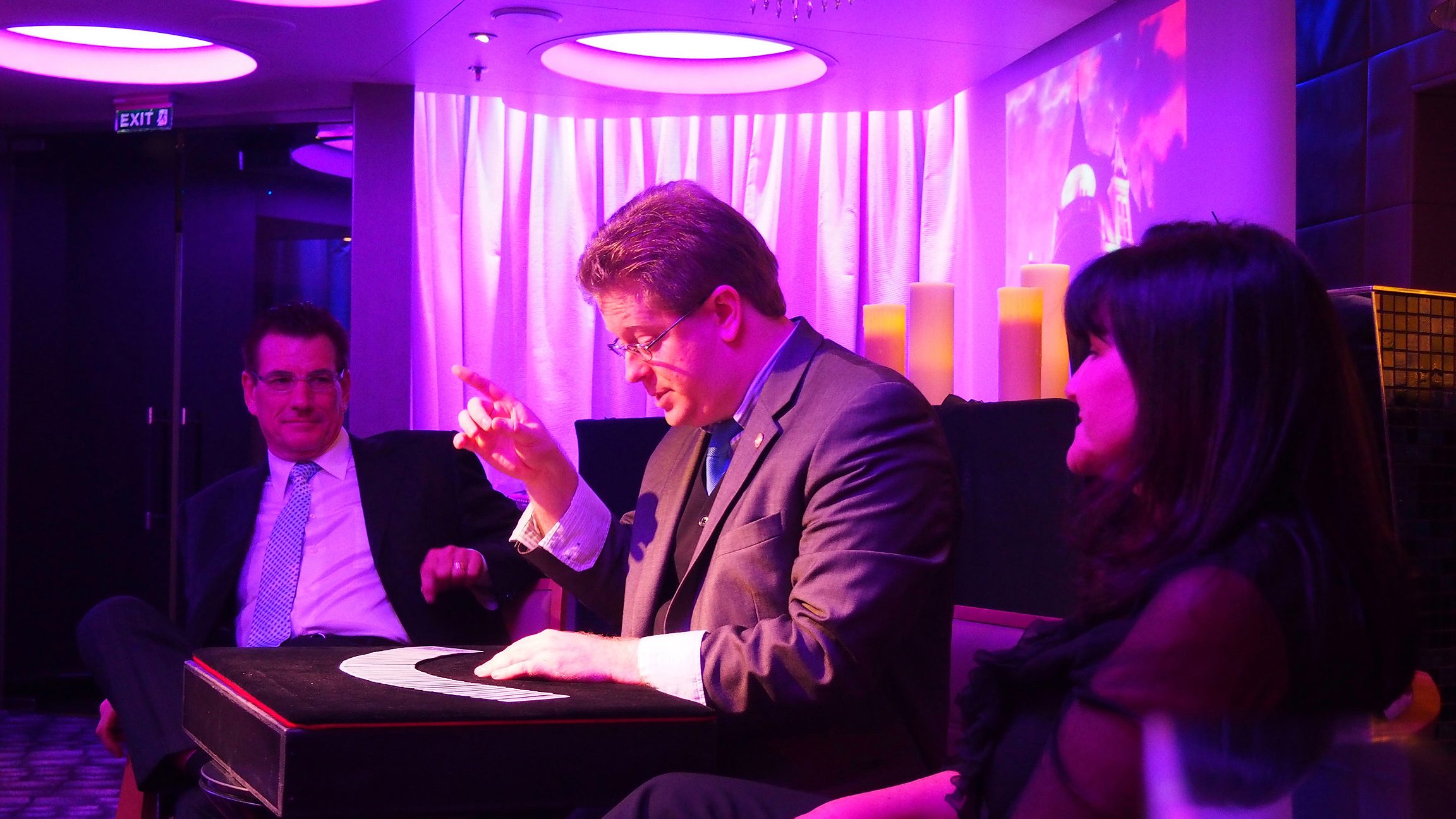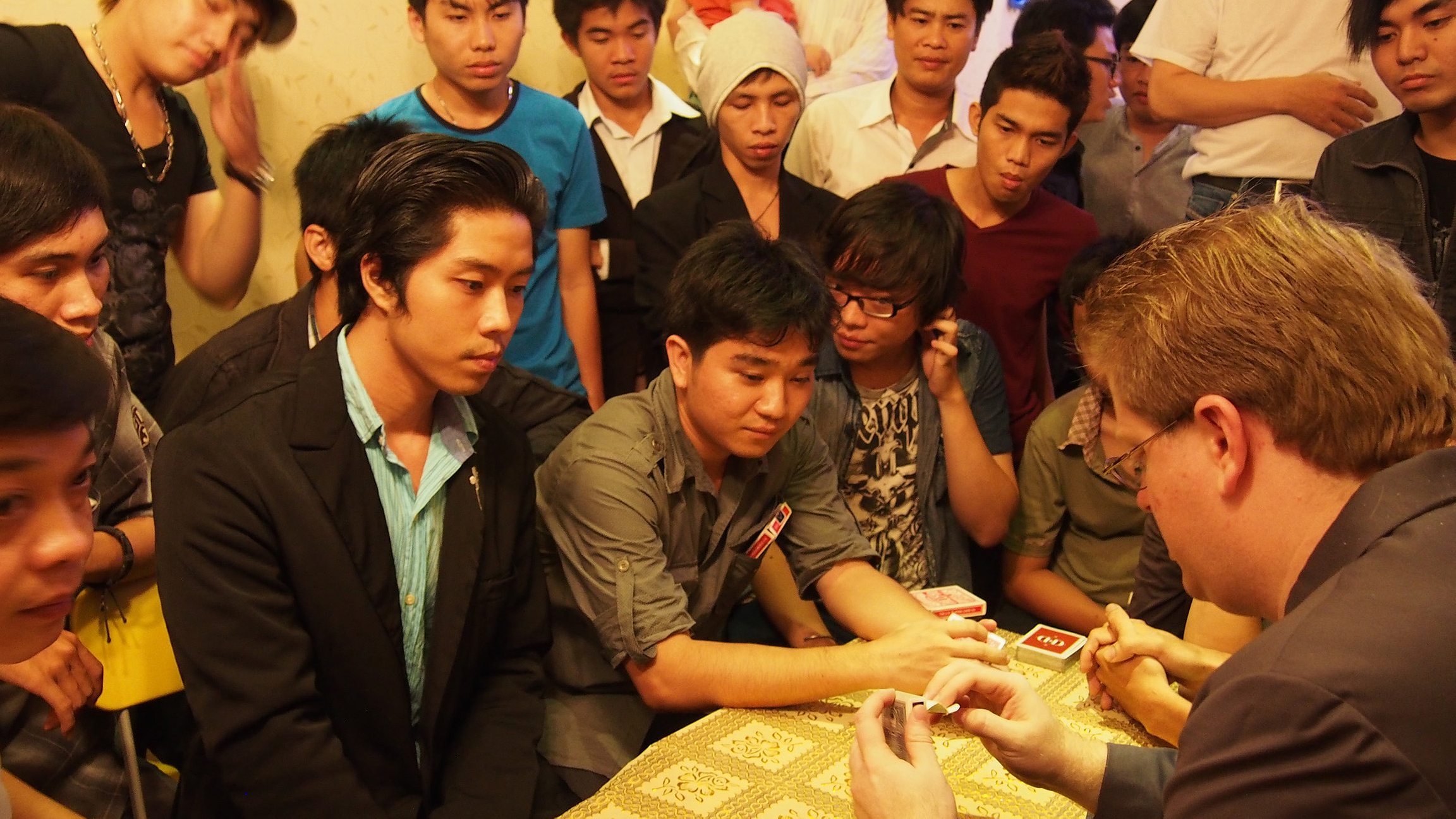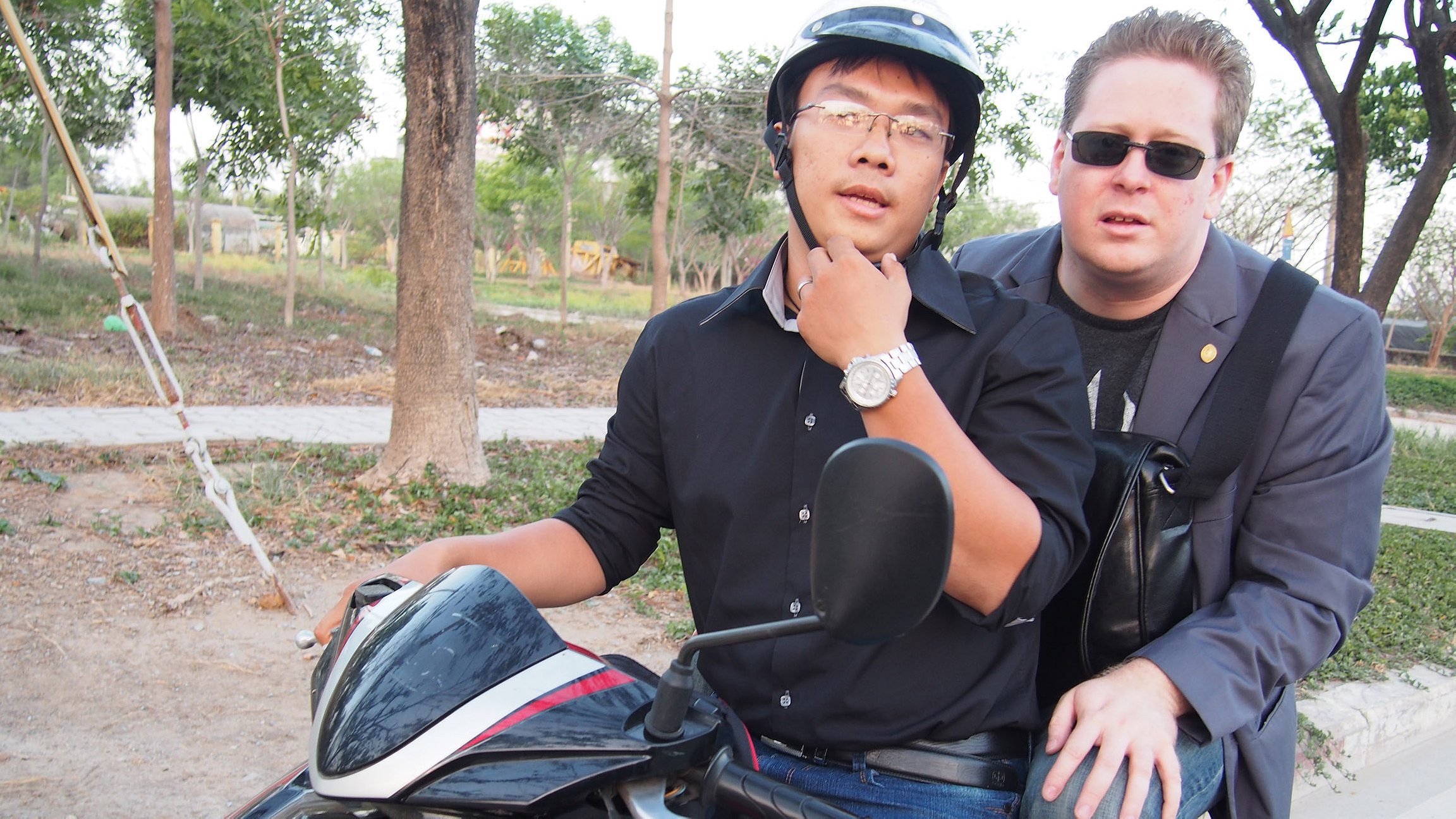On the road in Vietnam with one of the world’s most famous close-up magicians.
What’s the plan, exactly?” It’s 5:30 in the afternoon and I’m sitting on the curb outside the Saigon port with a magician and a crew of wiry Vietnamese taxi drivers.
“I’m not really sure.”
“Well, what did they tell you?”
“That they’d pick us up here and take us into the city.”
“But you do this all the time?”
“All the time. Most ports we hit. Normally we just go to a bar, show each other different card tricks. Super causal. ”
“And you told them I’m coming?”
“I did, but I said you’re a magic journalist.”
“A magic journalist?”
“They won’t share secrets around a lay person. You need to be part of the community. It’ll be fine—just play it cool.”
While I ponder the potential benefits of being a member of the international magic community, a pair of young Vietnamese pulls up on scooters.
“Mr. Jon Armstrong?”
We each hop onto a bike and ride off, helmetless, into the Saigon sunset. After some gentle probing, I realize my driver, a sweet girl with a perfectly round face who tells me to call her Annie, has no idea who we are and even less of an idea of where we are going.
The confusion is compounded moments later when two men on scooters pull up next to us on the road and begin to shake their fists. It seems the local taxi racket doesn’t take kindly to strangers swooping into the port and picking up two potential fares without clearing it with the rest of the concern. So they give chase, following us for the better part of 10 minutes, demanding a $5 kickback and eventually pinning us against the side of the road. A few minutes later, a police officer arrives to mediate, finally deciding that the foreigners don’t owe the scooter toughs a dime.
When we finally enter Saigon, absorbed by the locust chorus of motorbikes and street vendors, the sun has set and the night air smells of fish sauce and exhaust. We pull up to the meeting spot, a coffee and teashop in District 1, where an 8-foot mounted poster announces the evening’s entertainment: “Jon Armstrong from Los Angeles, USA”, along with a dark silhouette of his bespectacled face.
“Looks like I’ll be performing.”

Jon Armstrong’s first magic lesson came when he was 8 years old. His dad picked up a few card tricks in the Air Force, and he taught his son how to cheat at gin rummy. Armstrong grew up in Orlando, close to where the magic is made, so he parlayed his father’s lessons and his own studies into a job at Epcot Center, a job that he secured by faking an English accent. “I was from Manchester for about three weeks. Then I was from Oxford.”
Eventually Armstrong made his way west to Vegas, to the dark heart of the illusive arts, where he worked headlining Caesar’s Magical Empire, a venue that helped launch the careers of some of the country’s biggest magic acts. There, in an elaborately constructed 66,000-square-foot restaurant space, Armstrong and a band of magicians circled around rooms with names like the Chamber of Destiny and Forbidden Crypt, working the crowds of diners forking their way through sirloins and Caesar salads.
After Vegas, Armstrong migrated to the Magic Castle, Hollywood’s legendary private magic club, where he took up the charge of Chairman of the Academy of Magical Arts Trustees. Since landing in California, he’s been twice named the Close-Up Magician of the Year, has consulted on magic-heavy shows like The Mentalist and X Files, helped open up two close-up magic theme parks, and performed his unique brand of comedy-soaked sleight of hand in over 40 countries around the world.
When I first met Armstrong, we were eight miles off the coast of Malaysia, en route to Bangkok aboard the Crystal Symphony, a luxury liner widely considered to be the best cruise ship in the world, which made the curious decision to invite Roads & Kingdoms along for a free ride to Vietnam. Armstrong, for the past month, has been Crystal’s magician in residence, not only performing 30-minute shows to intimate groups of passengers on cruising days, but also spontaneously dropping into the various bars scattered across the ship to queue up a cocktail and wobble the minds of the whisky-drinking set.
His act on the boat is decidedly low budget; it involves a deck of cards, two rubber bands and a mini toilet plunger no larger than a lollipop. This is not stage magic; there are no special lights or fog machines or dramatic music piped in through the ship’s speaker system. Before he comes out on stage—really, a bar with leather couches and neon purple backlighting—he hides behind a curtain and announces himself.
Armstrong specializes in close-up magic, also know as micromagic or table magic. According to him, his talent involves a carefully measured cocktail of “physical dexterity, mental acuity, deception, and the occasional gag.” With a snap of the fingers, he splits the deck between reds and blacks. Another snap and they’re perfectly dispersed: red, black, red, black. He’ll pluck your phone number, card by card, out of the deck in a way that will make you want to call your provider and change your digits.
Beyond the memory tricks and sleights of hand, Armstrong’s act, like many modern magicians, leans heavily on comedy. He balances gentle audience ribbing with self-deprecating cracks and well-practiced one-liners, so that when you watch him, you’re not sure if you’re at a magic show or a comedy club. Which is exactly the point.
Perhaps Armstrong’s most popular bit involves the tiny plunger, “just like the one you’d find in any Barbie Dream House.” It’s genius, like the best close-up magic, lies in its simplicity: portable, familiar, and incapable of arousing suspicion. He brought the tiny plunger with him recently onto the Today Show, where he unleashed it on Hoda and Kathy Lee in the 10 o’clock hour. For his grand finale, he has Kathy Lee whisper her card to the plunger, then proceeds to plunge her card directly from the deck. Hoda eats it up. “Now that’s how you end a segment.”
Armstrong’s current closer is established at the start of his show when he passes a tiny box to someone in the crowd and asks him to put it in his pocket. As the performance winds down, Armstrong asks a handful of people to sign their names on a card with a Sharpie. After a series of manipulations that quickly ratchet up the suspense, the man pulls out the tiny box and finds the autographed card is inside. People go nuts.
As a few of the only late-nighters onboard the Symphony, Armstrong and I spent a good amount of time in the casino or one of the ship’s many lavish bars, drinking gin and tonics (“bars and magic go great together” he likes to say) and talking magic.
“I know this might surprise you, but I was a bit of a nerd growing up.” It’s true, he doesn’t cut the coolest figure—a doughy 37-year-old with glasses and a baby face and strawberry-blonde eyebrows that seem to be perpetually arched. At sea, he wears a dark jacket and a dark vest with a pocket watch that dangles by his ribcage. On land, the same jacket, but he swaps the vest for a black Batman shirt.
If Armstrong has a cool factor, beyond his ability to blow your mind, it’s his connection to Hollywood. He was the consulting magician for the three-season cult favorite Arrested Development, the man charged with the duty of turning Gob Bluth (played by Will Arnett) into one of the world’s worst magicians. “Will wanted to learn how to do all of the tricks first so that he understood exactly how to screw them up.” (For those Arrested nerds out there, Armstrong’s greatest contribution to the show is one of Gob’s signature lines: “But where did the lighter fluid come from?”)
The Alliance of Magicians, the group that blacklists Gob for inadvertently revealing one of his tricks, is based on the Magic Castle’s Academy of Magic Arts, an earnest association of performers who take their craft—and its secrecy—very seriously. It’s through Castle connections that Armstrong finds himself onboard the Crystal Symphony, and through their vast network of alliance-affiliated magicians, we find ourselves in a teashop in Saigon, surrounded by pack of card-carrying close-up trainees.

Jesse’s iPhone wallpaper is a picture of herself in a rainbow bikini. She wears a low-cut black dress with a butterfly belt and a thick layer of Ferrari-red lipstick. “I like magic, but cards aren’t my thing. I work with doves.”
She is the one of the leaders of Saigon’s Magic ATG Club, the group of magicians that invited Armstrong here tonight, and she greets us as we enter the tiny room on the fourth floor of the teashop. Inside, no fewer than 30 young Vietnamese crowd around two long tables, warming up for the evening. Not an insignificant number of them wear pinstripes and polyester suits, and every single person in the room has their fingers wrapped around a deck of cards.
“Asian magicians love to work the cards. They love flourish,” Armstrong says as we make our way though the crowd. Flourish is the technical term for special shuffling and card contortion, with a vast subgenre of moves with names like the Charlier Cut, the LePaul Spread and the Anaconda. The room is thick with Vietnamese kids manipulating decks into elaborate shapes like a crew of street kids throwing up gang signs. We walk up to a young man with long hair pulled back into a ponytail and Armstrong asks him to show us his best stuff.
The boy pushes up his sleeves and goes to work, fanning the cards into impossible shapes, raining them down in elaborate waterfalls of laminated cardboard. “Very nice,” says Armstrong.
“I did magic for five years, then I became frustrated because magic requires an audience,” the flourisher tells me. “Art doesn’t. That’s why I switched to fire.”
Cameras are set up on tripods around the room. Coffee and tea and tropical fruit plates make the rounds. ATG Club members give speeches in Vietnamese welcoming Armstrong and his magic journalist companion. Finally Armstrong takes the stage and offers a few words of his own. “From our club to your club, it’s an honor to be here.” Though he smiles broadly, his face betrays an unmistakable confusion; the only contact he’s had in advance of the evening was a series of vague Facebook messages asking if he’d like to “hangout” while in town.
But Armstrong’s a natural performer, and he doesn’t waste time worrying about decorum and expectations. He takes a seat at a table, tops it with the felt mat that all close-up magicians use to keep their tricks clean and visible, and goes to work on the young crowd. When he pulls out the plunger and sticks it to someone’s head (“it will now read your mind”), then proceeds to plunge his way directly to the guy’s card, the room roars.
“We have all spent years watching the Jon Armstrong DVDs,” says Duong Ngoc Minh Triet, the group’s president. “Now all of a sudden he’s here performing magic for us. It’s an incredible honor.”

Magicians make an easy target. They wear costumes. They tell bad jokes. They come across as more likely to curl up with a game of Dungeons and Dragons than a blond groupie they met backstage.
It doesn’t help that some of the magic world’s most familiar faces—Siegfried and Roy, Criss Angel—evoke cringes more than wide eyes of wonder. The fact that Incredible Burt Wonderstone, the newly released movie about the rivalry between an aging stage act and a rising street artist, stars Jim Carrey and Steve Carell tells you all you need to know about the mainstream perception of the magician.
Armstrong understands the stereotypes and works effectively within their parameters. “I’m kind of an important person in the magic world,” I often hear him telling people on the boat. “Which is kind of like saying I’m an important gold fish collector.”
He counts three magicians as his heroes: Don Alan, whose Magic Ranch television show in the early 60s turned close-up magic from an intimate spectacle to a national narrative; Albert Goshman, a mustachioed bagel baker from Brooklyn, known for doing incredible things with coins and salt shakers; and Martin Nash, the Charming Cheat, a Magic Castle regular whose tuxedo charm and olive oil voice helped him steal the shirt off your back without you ever knowing.
“What these three guys have in common is the magic they did supported who they were. Not, ‘I do something interesting, therefore I am interesting.’ More like ‘I’m interesting, so I do interesting stuff.’”
Armstrong clearly sees himself in a similar light. When not holding court at the Magic Castle or advising big-name actors on how to get the doves to behave, he’s traveling the world, connecting with bands of magicians and magic fans who have studied his brand of close-up manipulation. As the voice at the end of Armstrong’s promo video puts it: “He’s proven time and again all over the world ‘Jon Armstrong is a universal language.’”
Magic as a universal language, a purely visual spectacle that needs no interpretation, is a well-worn cliché, but Armstrong’s travels have taught him a lot about the regionalization of illusion.
“Euro magic has a tendency to focus on plays on words, card puns, a bit cheesy, but still very smart. The guys I just met in Singapore do very open displays of skill—there’s a huge tradition of that there.”
“A friend of mine went to North Korea twice to perform. He said it’s very orchestrated magic but it was like someone had gone into a time machine and went back 50 years and performed with handmade props. All in the service to North Korea’s national heroes.”
Dear Leader aside, his recent travels throughout Asia have impressed upon him the shifting dynamics in the global magic scene.
“Modern close up is an American thing, but they’ve picked it up very quickly in this part of the world and sometimes surpass what we do. A lot of Asian acts will do close up to music, syncopated rhythm, stuff like that. “
Back at the Saigon teashop, the Asian flourish is in full force. Armstrong has wrapped up his act and now the audience of magicians-in-training is lining up to show off their best stuff to the American. “Great displacement,” he says as the kid with the jean jacket snaps his fingers and disappears a card.

With Armstong’s line stretching out the door, they soon form a second line behind the big-shot magic journalist. I play along, dropping the few words of jargon I’ve picked up from Armstrong and feeling generally relieved that no one here speaks English particularly well.
They may be young, but these kids know how to work a deck of cards. A 14-year-old boy with thick glasses erects a card pyramid between his tiny fingers. A punk rock kid named Fry Duck rubs the deck with the palm of his hand and seamlessly moves cards up and down the stack. A third can’t quiet get his mojo going, swapping decks with friends and cursing himself in Vietnamese.
“It’s hard to work close up in Vietnam weather,” the club president leans in to tell me. Even inside with a handful of fans at full blast, I can feel the sweat on my fingertips.
The magic movement is new in Vietnam, not more than 15 years old, but according to everyone I talk to, it’s exploded here in the south. “YouTube changed everything for us,” says Palmas Nguyen, vice president of ATG. “Suddenly we could watch guys like Jon Armstrong and study his moves.”
ATG has more than 40 members, from 9 to 72 years old, though the vast majority are teenagers. “It’s the easiest way to get girls,” Fry Duck says, fanning out his deck and waving it at a girl sitting in the corner.
The ATG crew explores all veins of magic, but one look around the room will tell you where their loyalty lies. “Everybody here works the cards,” says Nguyen. “A deck of cards is the one thing we can all afford.”
It’s not simply a matter of economics, though. Talk to the young guys here and you’ll discover that purity is paramount: they view stage magic, and even comedy, as a lesser form of the craft. “We don’t want gimmicks,” Fry Duck says. “We want 100 percent sleight of hand. To us, that’s art.”
While we talk, a tall, lanky kid performs an elaborate bit of flourish that eventually segues into a trick. When he’s done, he looks up at Armstrong expectantly. Armstrong shakes his head. “To be honest, you lost me.”
On the way back to the ship, a few of our new friends take us to a street corner for a bowl of noodle soup—the kind of heady 50-cent fare you can only find on the streets of Saigon.
I ask Annie, my round-faced scooter chauffeur, if she enjoyed the show.
“I watch and I watch and I just can’t figure it out. He’s a genius.”
I turn to Armstrong, who stops slurping just long enough to manage a shrug and a little smile. “Not a bad way to make a living.”